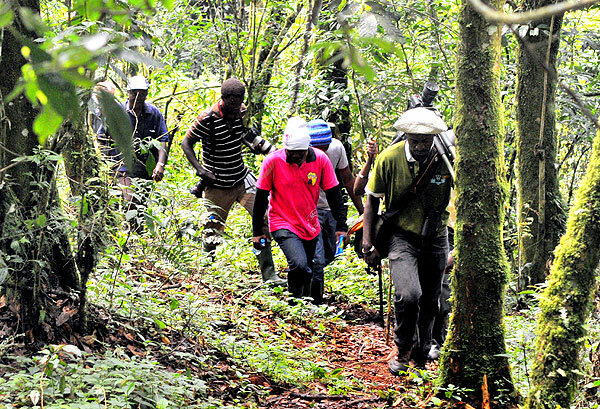New census for Bwindi gorillas
Oct 16, 2011
The Uganda Wildlife Authority (UWA) has launched a new census of the mountain gorilla population in Bwindi impenetrable national park to assess their numbers and document information on poaching and other illegal activities.

By Francis Kagolo
The Uganda Wildlife Authority (UWA) has launched a new census of the mountain gorilla population in Bwindi impenetrable national park to assess their numbers and document information on poaching and other illegal activities.
The census is also intended to estimate the population of other mammals like bush pigs, elephants, and monkeys and human activities in the park for planning and conservation purposes.
The census if funded by the international gorilla conservation programme, a global agency dedicated to protecting gorillas and their habitat, to the tune of $100,000 (about sh280m).
According to Martha Robbins, the German expert leading the census, the team counts gorilla nests, other than individual gorillas, and collect their feaces. The feaces will be used for generic analysis which, she said, provides the most accurate estimates.
The team, comprising of Ugandans, Rwandese and DR Congo wildlife experts traverses the entire 331sq.km forest in a zigzag style in search for fresh gorilla trails until their nests are found and counted.
This is the fourth gorilla census conducted since Bwindi was gazetted a national park in 1991 and declared a Natural World Heritage Site by Unesco in December 1994. The first census of 1997 revealed 300 gorillas while the number increased to 320 in 2002.
However, in 2006 when the generic census analysis was first introduced, the number fell to 300. Robbins could not give projections for this year, saying the results would come out next year after the generic analysis is completed at a laboratory at Germany-based Max Plank Institute for Evolutionary Anthropology.

Journalists and UWA wardens climb the Bwindi Impenetrable National Park hills in the 2011 gorilla census exercise
Mountain gorillas, the backbone of Uganda’s tourism industry, are critically endangered, with only 720 individuals remaining in the world. These live in the three countries of Uganda, Rwanda and DRC.
Bwindi Park harbours half of the gorilla population and the remainder roams the Virunga ranges shared by the three countries.
Pontious Ezuma, the conservation manager for Bwindi, said the number of tourists tracking gorillas has increased from 1,313 in 1993 to 15,112 last year.
The number is expected to increase even further, thanks to three more gorilla groups which UWA is to open. The groups, including Oruzogo, Kahunge and Mishaya, which Ezuma said would be launched next month, habour over 60 newly habituated gorillas.
This will bring the number of habituated gorilla groups in the park to 10, one of which is reserved for only research purposes. With each group accommodating eight tourists daily, it means that the park’s annual capacity would increase from 20,440 to 26,280 tourists.
The number of gorilla-tracking tourists has been increasing annually, save for 1999 when it dropped from 2,437 in 1998 to 2,111. This arose after the killing of eight foreign tourists by the Interahamwe rebels from the DRC. Since then, the Government has tightened security arround the park, which Ezuma said is key for tourism growth.
